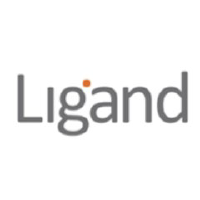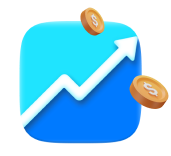- Chart
- Upturn Summary
- Highlights
- Revenue
- Valuation
 Upturn AI SWOT
Upturn AI SWOT - About
Ligand Pharmaceuticals Incorporated (LGND)

- BUY Advisory
- SELL Advisory (Profit)
- SELL Advisory (Loss)
- Profit
- Loss
- Pass (Skip investing)
 Stock price based on last close
Stock price based on last close (see disclosures)
- ALL
- 1Y
- 1M
- 1W
Upturn Advisory Summary
11/28/2025: LGND (3-star) is a STRONG-BUY. BUY since 118 days. Simulated Profits (77.53%). Updated daily EoD!
1 Year Target Price $237.5
1 Year Target Price $237.5
| 4 | Strong Buy |
| 3 | Buy |
| 0 | Hold |
| 0 | Sell |
| 0 | Strong Sell |
Analysis of Past Performance
Type Stock | Historic Profit 65.38% | Avg. Invested days 45 | Today’s Advisory Strong Buy |
Upturn Star Rating  | Upturn Advisory Performance | Stock Returns Performance |
Key Highlights
Company Size Mid-Cap Stock | Market Capitalization 4.00B USD | Price to earnings Ratio 89.11 | 1Y Target Price 237.5 |
Price to earnings Ratio 89.11 | 1Y Target Price 237.5 | ||
Volume (30-day avg) 7 | Beta 0.86 | 52 Weeks Range 93.58 - 212.49 | Updated Date 11/28/2025 |
52 Weeks Range 93.58 - 212.49 | Updated Date 11/28/2025 | ||
Dividends yield (FY) - | Basic EPS (TTM) 2.28 |
Analyzing Revenue: Products, Geography and Growth
Revenue by Products
Product revenue - Year on Year
Earnings Date
Report Date 2025-11-06 | When - | Estimate 1.93 | Actual 3.09 |
Profitability
Profit Margin 19.34% | Operating Margin (TTM) 46.85% |
Management Effectiveness
Return on Assets (TTM) 1.48% | Return on Equity (TTM) 5.42% |
Valuation
Trailing PE 89.11 | Forward PE 26.53 | Enterprise Value 3831642395 | Price to Sales(TTM) 15.92 |
Enterprise Value 3831642395 | Price to Sales(TTM) 15.92 | ||
Enterprise Value to Revenue 15.25 | Enterprise Value to EBITDA 37.94 | Shares Outstanding 19681720 | Shares Floating 19256398 |
Shares Outstanding 19681720 | Shares Floating 19256398 | ||
Percent Insiders 2.26 | Percent Institutions 106.45 |
 Upturn AI SWOT
Upturn AI SWOT
Ligand Pharmaceuticals Incorporated

Company Overview
 History and Background
History and Background
Ligand Pharmaceuticals Incorporated was founded in 1987. Initially focused on nuclear receptor technology, Ligand has evolved into a platform company that licenses its technologies and intellectual property to pharmaceutical and biotechnology companies. Key milestones include the development of Captisol and the strategic shift towards a royalty-driven business model.
 Core Business Areas
Core Business Areas
- Captisol: Captisol is a chemically modified cyclodextrin used to improve the solubility and stability of drugs. It's licensed to numerous pharmaceutical companies for use in their products. Revenue is generated through royalties and material sales.
- Promus Platform: Promus is a drug discovery platform focused on enabling the development of new and improved medicines. Ligand earns royalties and milestone payments from partnered programs utilizing the Promus platform.
- Vernalis Design Platform (VDP): A technology platform acquired from Vernalis that is generating value from partnered programs.
 Leadership and Structure
Leadership and Structure
Ligand is led by CEO Matt Foehr. The organizational structure includes departments focused on research and development, licensing, finance, and operations. The board of directors provides strategic oversight.
Top Products and Market Share
 Key Offerings
Key Offerings
- Captisol: Captisol enhances solubility and stability of drugs. While precise market share is difficult to ascertain due to its use across many partnered products, it's a leading solubilizing agent. Competitors include Kleptose (Roquette) and other cyclodextrins, as well as alternative formulation technologies.
- Kyprolis (Amgen - developed using Ligand technology): A proteasome inhibitor for multiple myeloma. Ligand receives royalties on sales. Amgen is the primary competitor in this market. Peak revenues were approximately $1.2B USD.
- Evomela (acquired from Spectrum Pharmaceuticals): Chemotherapeutic agent used in conjunction with high-dose melphalan conditioning prior to haematopoietic progenitor (stem) cell transplantation (HPCT). Competitors are other conditioning regimen agents. Ligand acquired this product and is generating revenue.
Market Dynamics
 Industry Overview
Industry Overview
The pharmaceutical industry is characterized by high research and development costs, stringent regulatory requirements, and intense competition. The market is driven by innovation, aging populations, and increasing healthcare spending. There's a growing trend towards outsourcing drug development and utilizing platform technologies.
Positioning
Ligand is positioned as a platform company, focusing on licensing its technologies and intellectual property to other pharmaceutical and biotechnology companies. Its competitive advantage lies in its established platforms and royalty-driven business model.
Total Addressable Market (TAM)
The TAM for drug solubilization and formulation technologies is estimated to be billions of dollars annually. Ligand is positioned to capture a portion of this market through its Captisol technology. The overall market for partnered drugs and biologics is significantly larger, but Ligand's share is dependent on the success of its partners' products.
Upturn SWOT Analysis
Strengths
- Established Captisol technology
- Royalty-driven business model
- Diversified revenue streams
- Strong partnerships with pharmaceutical companies
- Promus and Vernalis Design Platforms providing opportunity for future growth
Weaknesses
- Dependence on partners' success
- Limited direct control over drug development
- Potential for generic competition
- Concentration of revenue in a few key products
Opportunities
- Expanding Captisol applications
- Developing new platform technologies
- Acquiring complementary assets
- Entering new therapeutic areas
- Capitalizing on growing demand for outsourced drug development
Threats
- Patent expirations
- Regulatory changes
- Competition from alternative technologies
- Partner failures
- Economic downturn impacting pharmaceutical spending
Competitors and Market Share
 Key Competitors
Key Competitors
- VRTX
- AMGN
- MRK
Competitive Landscape
Ligand's competitive advantage lies in its royalty-driven business model, which reduces risk and capital requirements. However, it's dependent on the success of its partners. Vertax, Amgen, and Merck have broader pipelines and more direct control over drug development. The market share (%) are based on their drug's market and not market share for drug discovery.
Major Acquisitions
Pfenex
- Year: 2020
- Acquisition Price (USD millions): 437.5
- Strategic Rationale: Acquisition of Pfenex provides Ligand with a robust protein expression platform, expanding its drug development capabilities.
Vernalis
- Year: 2018
- Acquisition Price (USD millions): 43
- Strategic Rationale: Vernalis's Fragment and Structure Based Drug Discovery platform, combined with Ligand's other technologies, offers its partners broader drug discovery capabilities.
Growth Trajectory and Initiatives
Historical Growth: Historical growth has been driven by the success of partnered products and strategic acquisitions.
Future Projections: Future growth is projected to come from new Captisol applications, advancements in the Promus platform, and new partnerships. Analyst estimates are available from financial data providers.
Recent Initiatives: Recent initiatives include expanding the Captisol portfolio, developing new platform technologies, and acquiring complementary assets. For example, the acquisition of Pfenex added a protein expression platform.
Summary
Ligand Pharmaceuticals is a platform company with a diverse portfolio of technologies and partnerships. Its royalty-driven business model offers lower risk compared to traditional pharmaceutical companies. However, its reliance on partners and potential generic competition pose challenges. Key strengths lie in Captisol and other platform technology, while future growth depends on successful execution of partnerships and development of new technologies.
Similar Stocks
Sources and Disclaimers
Data Sources:
- SEC Filings
- Company Presentations
- Analyst Reports
- Ligand Pharmaceuticals Investor Relations
Disclaimers:
The information provided is for informational purposes only and should not be considered financial advice. Investment decisions should be made based on individual circumstances and consultation with a financial advisor. Market share estimations can be highly subjective.
 AI Summarization is directionally correct and might not be accurate.
AI Summarization is directionally correct and might not be accurate.
 Summarized information shown could be a few years old and not current.
Summarized information shown could be a few years old and not current.
 Fundamental Rating based on AI could be based on old data.
Fundamental Rating based on AI could be based on old data.
 AI-generated summaries may have inaccuracies (hallucinations). Please verify the information before taking action.
AI-generated summaries may have inaccuracies (hallucinations). Please verify the information before taking action.
About Ligand Pharmaceuticals Incorporated
Exchange NASDAQ | Headquaters Jupiter, FL, United States | ||
IPO Launch date 1992-11-18 | CEO & Director Mr. Todd C. Davis Ph.D. | ||
Sector Healthcare | Industry Biotechnology | Full time employees 68 | Website https://www.ligand.com |
Full time employees 68 | Website https://www.ligand.com | ||
Ligand Pharmaceuticals Incorporated, a biopharmaceutical company, develops and licenses biopharmaceutical assets worldwide. It offers Pradefovir, Posaconazole, Voriconazole, CAPVAXIVE, NOXAFIL, MenFive, and ZELSUVMI for infectious disease; EVOMELA and KYPROLIS for multiple myeloma; FILSPARI, a dual endothelin and angiotensin II receptor antagonist for immunoglobulin A nephropathy; Ohtuvayre for respiratory disease; PNEUMOSIL, a pneumococcal conjugate vaccine to help fight against pneumococcal pneumonia in children; and QARZIBA to treat neuroblastoma. The company also provides Teriparatide injection product for osteoporosis; RYLAZE, a recombinant erwinia asparaginase for acute lymphoblastic leukemia or lymphoblastic lymphoma in adult and pediatric patients; TZIELD, a CD3-directed antibody indicated to delay the onset of Stage 3 type 1 diabetes in adults and children aged 8 years and older with Stage 2 T1D; and VAXNEUVANCE for the prevention of invasive disease caused by streptococcus pneumoniae serotypes. In addition, it offers Duavee for menopause; Frovatriptan to treat Neurology; FYCOMPA and SESQUIENT for CNS; LYTENAVA to treat Opthamology; MEKINIST for cardiology; MINNEBRO for metabolic disease; Nexterone, a captisol-enabled formulation of amiodarone; VEKLURY, an antiviral treatment for COVID-19; and Viviant for osteoporosis. Further, the company develops ACLX-002, Ciforadenant, UGN-301, Viright, JZP341, MB07133, BOT/BAL, and Lasofoxifene for oncology; Ensifentrine for respiratory disease; QTORIN for rare disease; Sparsentan for kidney disease; VK2809 for hepatology; ANEB-001 for acute cannabinoid intoxication; CE-furosemide for cardiology; CE-Meloxicam for neurology; V117, CX2101A, and Sitavig for infectious disease; REV-0100, OPT-302, and Reproxalap for opthamology; Vilazodone and Topiramate Injection for CNS; VK0214 for Rare Disease; and VK5211 for musculoskeletal disorder. The company was incorporated in 1987 and is based in Jupiter, Florida.

Note: This website is maintained by Upturn Corporation, which is an investment adviser registered with the U.S. Securities and Exchange Commission. Such registration does not imply a certain level of skill or training. Investing in securities has risks. Past performance is no guarantee of future returns. No assurance is provided as to any particular investment return, and you may lose money using our services. You are strongly advised to consult appropriate counsel before making any investments in companies you learn about through our services. You should obtain appropriate legal, tax, investment, accounting, and other advice that takes into account your investment portfolio and overall financial situation. You are solely responsible for conducting due diligence on a potential investment. We do not affect trades for you. You will select your own broker through which to transact. Investments are not FDIC insured, they are not guaranteed, and they may lose value. Please see the Privacy Policy, Terms of Use, and Disclosure for more information.
 Home
Home 
